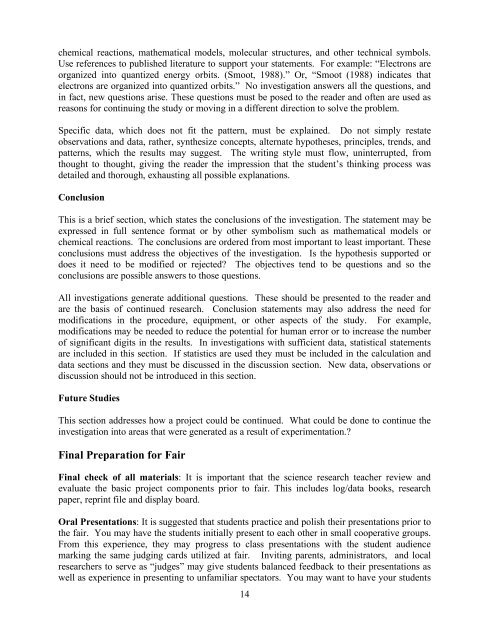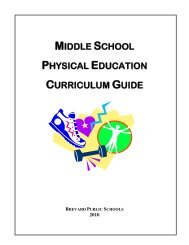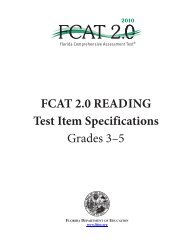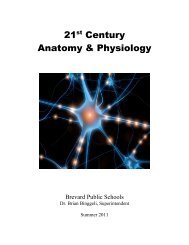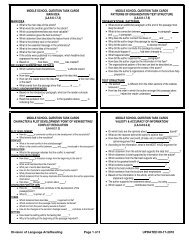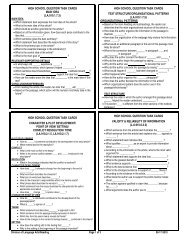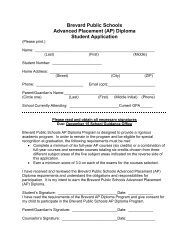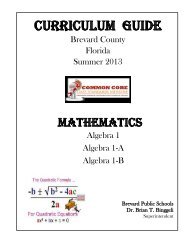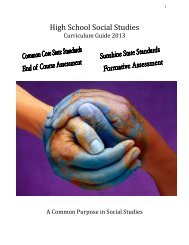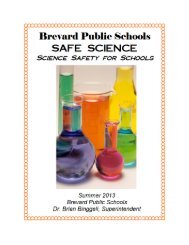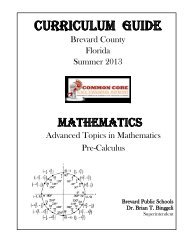Science Research Program Guide - Secondary Programs Home ...
Science Research Program Guide - Secondary Programs Home ...
Science Research Program Guide - Secondary Programs Home ...
You also want an ePaper? Increase the reach of your titles
YUMPU automatically turns print PDFs into web optimized ePapers that Google loves.
chemical reactions, mathematical models, molecular structures, and other technical symbols.<br />
Use references to published literature to support your statements. For example: “Electrons are<br />
organized into quantized energy orbits. (Smoot, 1988).” Or, “Smoot (1988) indicates that<br />
electrons are organized into quantized orbits.” No investigation answers all the questions, and<br />
in fact, new questions arise. These questions must be posed to the reader and often are used as<br />
reasons for continuing the study or moving in a different direction to solve the problem.<br />
Specific data, which does not fit the pattern, must be explained. Do not simply restate<br />
observations and data, rather, synthesize concepts, alternate hypotheses, principles, trends, and<br />
patterns, which the results may suggest. The writing style must flow, uninterrupted, from<br />
thought to thought, giving the reader the impression that the student’s thinking process was<br />
detailed and thorough, exhausting all possible explanations.<br />
Conclusion<br />
This is a brief section, which states the conclusions of the investigation. The statement may be<br />
expressed in full sentence format or by other symbolism such as mathematical models or<br />
chemical reactions. The conclusions are ordered from most important to least important. These<br />
conclusions must address the objectives of the investigation. Is the hypothesis supported or<br />
does it need to be modified or rejected? The objectives tend to be questions and so the<br />
conclusions are possible answers to those questions.<br />
All investigations generate additional questions. These should be presented to the reader and<br />
are the basis of continued research. Conclusion statements may also address the need for<br />
modifications in the procedure, equipment, or other aspects of the study. For example,<br />
modifications may be needed to reduce the potential for human error or to increase the number<br />
of significant digits in the results. In investigations with sufficient data, statistical statements<br />
are included in this section. If statistics are used they must be included in the calculation and<br />
data sections and they must be discussed in the discussion section. New data, observations or<br />
discussion should not be introduced in this section.<br />
Future Studies<br />
This section addresses how a project could be continued. What could be done to continue the<br />
investigation into areas that were generated as a result of experimentation.?<br />
Final Preparation for Fair<br />
Final check of all materials: It is important that the science research teacher review and<br />
evaluate the basic project components prior to fair. This includes log/data books, research<br />
paper, reprint file and display board.<br />
Oral Presentations: It is suggested that students practice and polish their presentations prior to<br />
the fair. You may have the students initially present to each other in small cooperative groups.<br />
From this experience, they may progress to class presentations with the student audience<br />
marking the same judging cards utilized at fair. Inviting parents, administrators, and local<br />
researchers to serve as “judges” may give students balanced feedback to their presentations as<br />
well as experience in presenting to unfamiliar spectators. You may want to have your students<br />
14


